My roof is curved, so adding a conventional vent will require some modification. I was wondering if anyone is using this smaller vent? I think it could be installed on a curved roof.
How have you handled the round top roof problem?
Anybody have one of these vents on their roof?
12 posts
• Page 1 of 1
Anybody have one of these vents on their roof?
- Attachments
-
- vent.JPG (26.72 KiB) Viewed 4222 times
Last edited by Tukanu on Sat Nov 02, 2019 10:34 am, edited 1 time in total.
Building lil' Woody: viewtopic.php?f=50&t=71953
-

Tukanu - Teardrop Advisor
- Posts: 81
- Images: 0
- Joined: Thu Jun 27, 2019 2:45 pm
Re: Anybody have one of these vents on their roof?
How have you handled the round top rood problem?
When you say round, just how much curve do you have? (I see how much curve you have on your build log.) But let's get objective vs. subjective.

Set a 14" piece of wood where you want the vent fan and measure how much gap is exposed on the ends. I'll bet it's less than 1/8".

Tony
-

tony.latham - Gold Donating Member
- Posts: 7073
- Images: 17
- Joined: Mon Jul 08, 2013 4:03 pm
- Location: Middle of Idaho on the edge of nowhere






